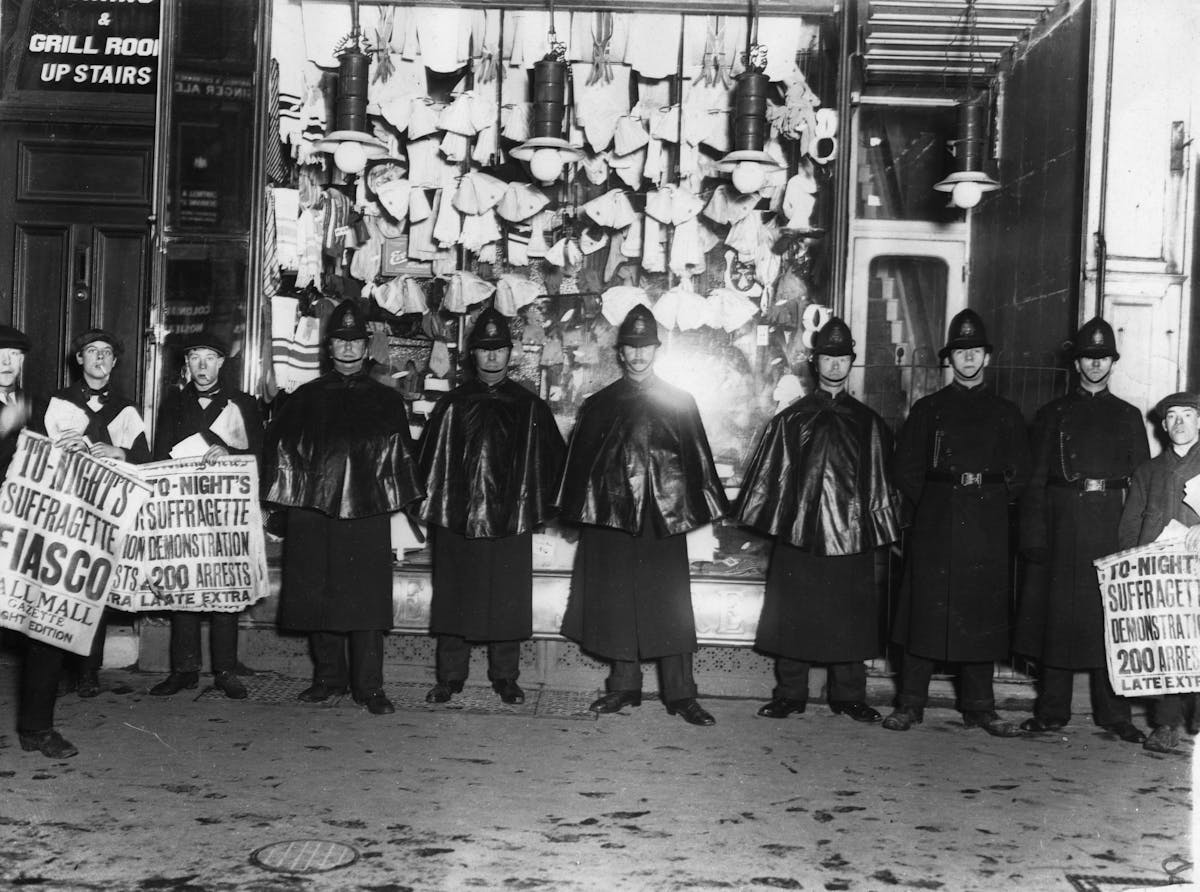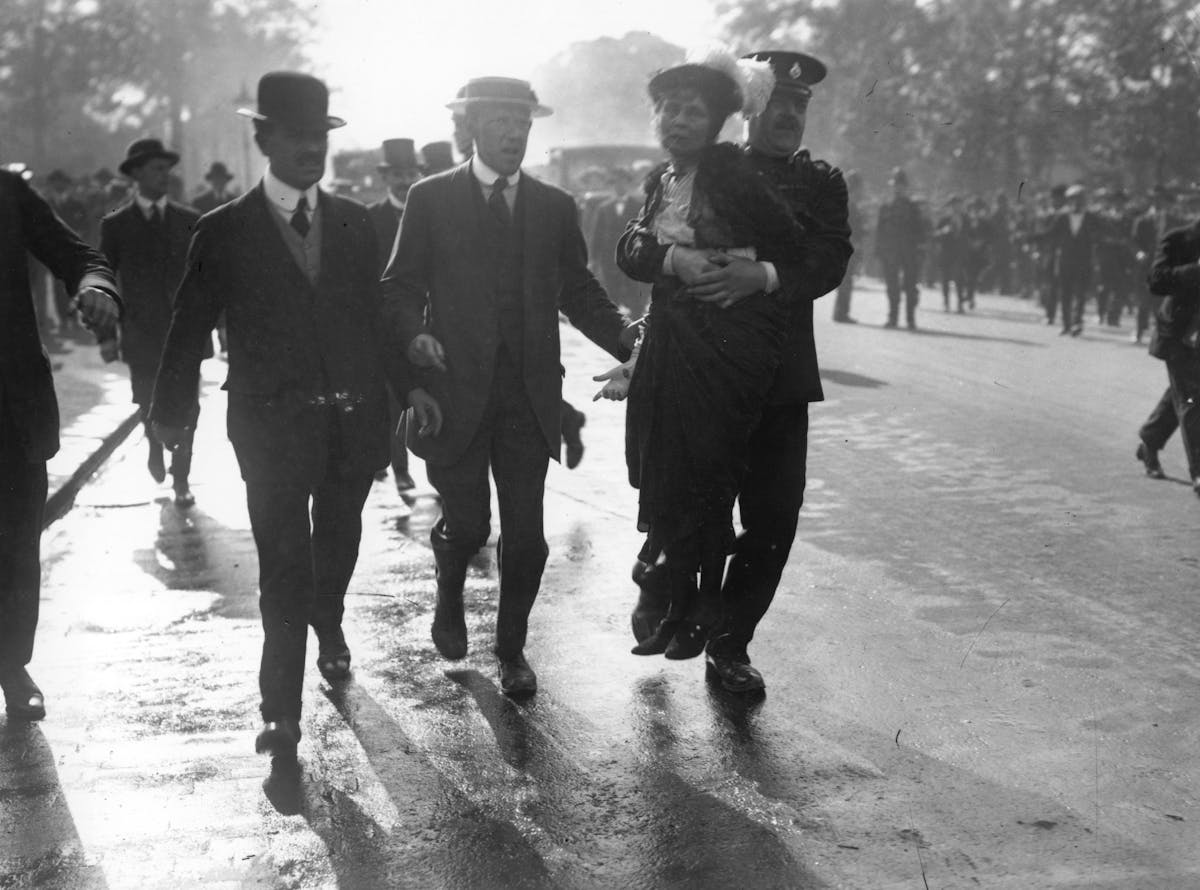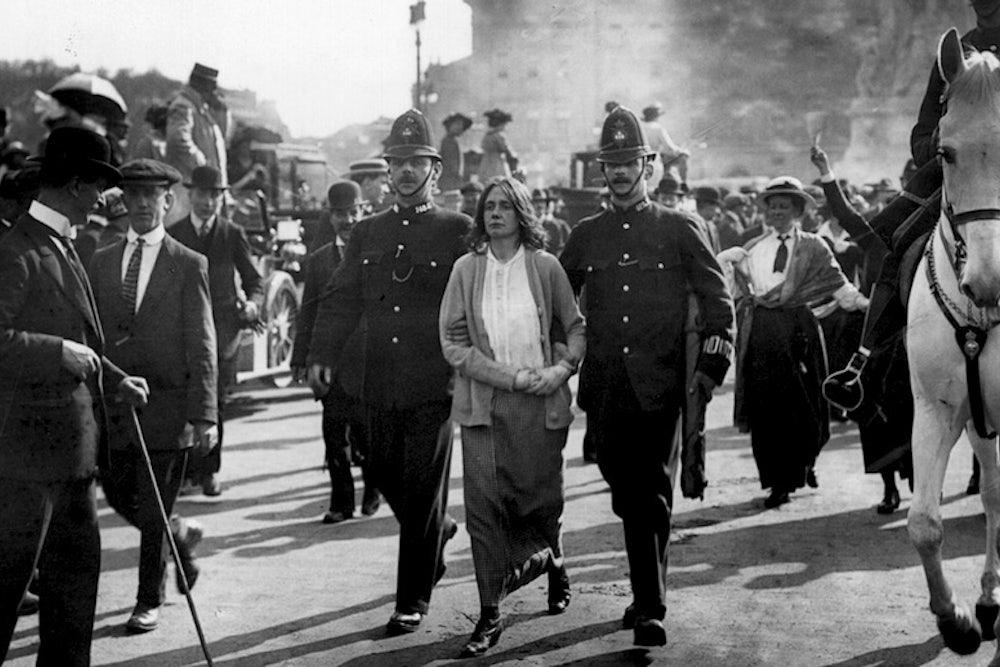One wonders why Suffragette—a glossy feature film about how women gained the vote in Britain—did not place at its center a devoted, if perhaps divisive movement leader in the vein of Malcolm X or Milk or Gandhi. Emmeline Pankhurst, who founded the militant Women’s Social and Political Union (WSPU) in 1903, would have been an obvious choice: a woman whose impassioned, often monomaniacal zealotry would illuminate both the movement’s obvious righteousness and its glaring blind spots. But Pankhurst, played by Meryl Streep, is a supporting role; the heroine of this movie is a benign, loving—and fictional—activist named Maud Watts, played charmingly by Carey Mulligan. The movie opens in 1912, just as the cause is gaining traction, and the politically pure Maud is gradually pushed into action and sacrifice by her fundamentally ethical nature, which is wonderful news for the working-class British women she is friends with, but for us, it’s an ill omen—a sign that Suffragette is a flattened, lackluster portrayal of a movement at a critical tipping point.
Using an everywoman as your audience proxy makes sense if your goal is to nudge skeptical viewers toward sympathy with a contentious cause. This oblique move makes less sense for Suffragette, since the struggle for suffrage is one almost the entire audience will surely support. Maud, who works in a laundry, is initially more interested in mundane concerns, like caring for her child and not getting killed at work. (Laundry work in the early twentieth century may not sound dangerous, but between the wringers and the abrasive chemicals, it was a hazard to life and limb.) But when she’s asked to testify about a working woman’s lot in life in front of the Liberal politician and future prime minister, David Lloyd George, who is collecting women’s experiences to bolster support for universal suffrage, she is transfixed by the possibility of a better life. For murky reasons (an episode in which she walks in on her boss groping a friend’s teenage daughter is clearly a motivating factor), Maud becomes increasingly convinced that, if things are to get better for women like her, then they will need the right to vote.
Maud is first arrested in the police-instigated riot that ensues after Lloyd George reports the suffrage bill has failed, the one Maud believed her testimony would help secure. (He would not succeed with suffrage until the devastating losses visited on a conscription army—largely composed of disenfranchised men—made reform morally imperative after World War I.) She tells the police investigator who interrogates her, “I’m not a suffragette,” but she can’t resist sneaking out of the house to hear Pankhurst speak, and is soon getting involved in plans for arson and bombings. After her second arrest and jail time, her husband kicks her out of the house and eventually puts her son up for adoption. But even through the beatings, the force-feedings in prison, and the dissolution of her family, Maud remains resolute, mainly because she’s the movie’s focal point. Her own motivations, whatever wrestling she may do with her upbringing and her conscience, remain opaque throughout the rest of the movie’s depiction of arson, arrests, and an eventual martyrdom.
To be effective, a movie about social justice has to aim higher than just “here’s how we won.” It should show the arguments, the missteps, the feet in mouths—the way flawed people with one right idea and a lot of wrong ones can come together to be historically, brilliantly impolite. It should evoke empathy for its characters’ failings and for the imperfect activists of today as they stumble similarly along. With Maud as its naïve figurehead, Suffragette dodges these complex and unpleasant duties, leaving the film without enough weight behind it to land a punch.
The film’s guiding principle is Pankhurst’s credo, and the WSPU motto, “deeds, not words.” Helena Bonham Carter’s character, a pharmacist named Edith Ellyn, intones it to our hapless heroine, who later runs her fingers over the same phrase, scratched into the wall of her prison cell. “The finest eloquence is that which gets things done,” a sympathetic politician assures Maud—“deeds, not words” for the parliamentary set.
This motto represented an important shift for the women’s suffrage movement in Britain. Before the WSPU was founded, women who campaigned for voting rights had, for the most part, tried to work within the parliamentary system, often appealing to their better-positioned husbands to act as intermediaries. Their efforts came at a time when the vote was gradually being extended to more people in British society. (Before the Reform Act of 1832, only 3 percent of the male population had the vote.) A group of women calling themselves the Kensington Society were among those in the suffrage movement who attempted to piggyback on the next big reform, which came in 1867 and extended the vote to male heads of household above a designated means threshold. With the help of John Stuart Mill, they proposed an amendment that would include females who met the same requirements, an amendment that was ultimately voted down. Despite their defeat, mainstream women’s suffrage advocates remained overwhelmingly polite. They called themselves “suffragists”—the word “suffragettes,” conceived as an insult, hadn’t been coined yet—and they continued to hand out leaflets, campaign peacefully, and gently pressure local political candidates.

Emmeline Pankhurst and her daughters, Christabel and Sylvia, helped lead an infuriated faction that broke away from the milder suffragists. Their “deeds” looked like this: They held marches and rallies, they shouted and made scenes, unfurled their “Votes for Women” banners at public events, asked incessant questions of politicians, and generally made nuisances of themselves. As their frustration grew, their tactics included arson, blowing up empty houses, and attempting to set off a bomb at St. Paul’s Cathedral—the site of coronations and august state funerals. (An article from the January 1914 edition of The Suffragette declared “one year’s militancy ends: enormous damage in 1913,” and calculated the cost of the destruction, which included burning a peer’s £40,000 yacht.) And they put themselves at personal risk, chaining themselves to railings outside government offices and throwing stones through the windows.
“Around every one of these flinty messengers was wrapped a piece of paper with a question on it,” Pankhurst told American suffragists, who held a mass meeting in her honor at Carnegie Hall in New York in 1909. “We only threw them because we were not admitted to Liberal meetings and had no chance to ask our questions any other way.” Though she was welcomed that night by prominent American activists and writers, including Charlotte Perkins Gilman, Pankhurst’s British-style suffragette tactics did not catch on in the United States. Whereas the political process had repeatedly failed British women and ultimately radicalized them, American women had seen some gains during the course of the nineteenth century. Their moderate approach was rewarded as individual states and territories—Wyoming and Utah were the earliest—granted women the right to vote. By 1913, Pankhurst, by contrast, had hardened her line: “If any woman does not take part in militant action, she shares in the crime of the government.”
Like most rallying cries, “deeds, not words” is a simplification. The core distinction isn’t between speech and action. It’s a distinction between asking deferentially from within the boundaries dictated to you and choosing to break those boundaries. Almost every successful movement chooses eventually to become disruptive—the beer cans thrown at Stonewall, the stand taken at the Edmund Pettus Bridge in Selma, Alabama—and the story of that choice is vital. But that story needs to address not only the how, but the why—what tips the scales, what drives the oppressed to step outside the bounds of decorum, what makes sacrifices become worthwhile and who winds up making those sacrifices. The suffragettes are certainly no exception; what outrages are sufficient to make a group of people who had been trained to be genteel or subservient or both into stone-throwing harridans? Driven to more extreme action by the anguish of justice deferred, they took high Edwardian ideals of female frailty and vulnerability, and placed them at the center of their most disruptive acts—such as the hunger strikes that politicized their female bodies.
If we’re going to follow Emmeline Pankhurst’s false dichotomy between deeds and words, as the movie does with such commitment, I’ll come down on the side of words every time. Of all of the suffragettes, I sympathize most with Sylvia Pankhurst, Emmeline’s middle daughter, who is absent in the film—a pacifist who wrote an important history of the movement, but who split from her mother and sister’s destructiveness and unwillingness to take up other social issues. And as a words person, I (perhaps ironically) got a stronger sense of the modern resonances of the suffragette movement from Elizabeth Robins’s 1909 play Votes for Women!
Robins, an American actress, moved to London in 1888, where she performed in Ibsen’s A Doll’s House and helped bring Hedda Gabler to England for the first time. She had attended the mass outdoor rallies staged by the WSPU, and was impressed by the theatrics of the Pankhurst women’s movement. From there, she began to compose “the first thing I shall have written under the pressure of a strong moral conviction.” She was encouraged by George Bernard Shaw, Henry James, and even J.M. Barrie, who talked suffrage with her over tea.

In a scene from Votes for Women! where Miss Levering, a newly minted suffragette, argues with Mrs. Freddy Tunbridge, who supports women’s suffrage but decries disorderly methods, the central tension of the movement is distilled better than in any part of Suffragette. Miss L. and Mrs. F. have been discussing an incident where suffragettes caused a disturbance in Parliament; Mrs. F. maintains that they’ve set back the cause of women’s rights by being harridans instead of asking politely, and Miss L. points out, “There’s been more said and written about it in these ten days since the scene, than in the ten years before it.” (Jean, a naïve young woman, acts as a stand-in for the as-yet unconverted audience.)
JEAN: Didn’t Mr. Greatorex say women had been politely petitioning Parliament for 40 years?
MISS L: And men have only laughed.
JEAN: But they’d come round. Mrs. Tunbridge says, before that horrid scene, everything was favorable at last.
MISS L: At last? Hadn’t it been just as “favorable” before?
MRS. F: No. We’d never had so many members pledged to our side.
MISS L: I thought I’d heard somebody say the bill had got as far as that, time and time again.
JEAN: Oh no. Surely not—
MRS. F (reluctantly): Y-yes. This was only a resolution. The bill passed a second reading 37 years ago.
JEAN: And what difference did it make?
MISS L: The men laughed rather louder.
Parts of Votes for Women! are shockingly prescient—it even anticipates the “not all men” defense. (Mrs. Freddy: “You don’t think all men in Parliament are like that!” Miss Levering: “I don’t think all men are burglars, but I lock my doors.”) And by investigating this watershed moment in the life cycle of a movement, the disappointment and frustration that shifts wheedling to disobedience, Votes for Women! looks not only beyond its time, but beyond its cause, underscoring the resonance between this fight for justice and social justice movements today.
Reading this dialogue—even with the knowledge that these are two upper-class British women in a time period marked by elitism and colonialism, discussing a movement with complicated class relations—it’s impossible for me not to think of Marissa Johnson and Mara Jacqueline Willaford. This summer, these two young and very principled women interrupted a Seattle stump speech by Bernie Sanders to demand he address Black Lives Matter in much the same way the suffragettes interrupted parliamentary meetings to ask, “When will you give women the vote?” And like Mrs. Freddy Tunbridge with the suffragettes, white liberals chided them afterward for their disrespect. While Sanders called the situation “unfortunate,” many of his supporters, especially on social media, were more outspoken. “Please Don’t Let Idiots Ruin the #BlackLivesMatter Movement,” read one representative headline on an article by a white man. “This sort of activism strikes me as a self-inflicted blow to Black Lives Matter,” wrote Conor Friedersdorf, another white man, at The Atlantic. We would agree with you, scolded the respectability police, but with so little courtesy, how are you going to win us over? Miss L. had something to say about that: “Winning over the men has been the woman’s way for centuries. Do you think the result should make us proud of our policy? Yes? Then go and walk in Piccadilly at midnight.”
Deeds without words are meaningless, but words without deeds are weak. It’s clear in Robins’s play, as it became clear during the suffrage movement, that these words must at some point lead to action. Suffragette ends with a stunning act of self-sacrifice, one of the most dramatic events of the British suffragette movement. On June 4, 1913, Emily Wilding Davison, an activist who had been jailed nine times for disruption, stone-throwing, and arson, and who had been force-fed in prison 49 times—why isn’t the film about her?—threw herself at King George V’s horse during a derby race at Epsom Downs. She was trampled and died of her injuries on June 8. (The incident was caught on film, and it has been argued that Davison was not staging a political act of self-harm, but was trying to attach a suffragette sash to the horse’s bridle.) It’s a startling moment, not to mention a perfect analogy for the suffragettes who dared to cross the thin line between too mannerly and too extreme. But it, too, goes unexplained; Davison has maybe five lines in the film, none of which set up any possible explanation for her final act.
Perhaps that’s meant as an illustration that, once again, deeds speak more than words. And yet, as Davison’s body is carried off the track, we see a policeman pick up her “Votes for Women” sash and tuck it away, clearly hoping to obfuscate the link between Davison’s death and her cause. If such a policeman existed, his trick didn’t work; there was never any public doubt about her motives or convictions. Still, the inspector’s instinct to hide verbal evidence of Davison’s suffragette sympathies belies the movie’s supposed moral, and hints at the better film it could have been.
Nearly a century later, we can look back on the militant tactics of the suffragette movement with horrified fascination. Who were these women who endured force-feedings, threw stones, and died on the racetrack? The point of looking back—though not, alas, the clear point of Suffragette—is to recognize that the growing pains of the suffrage movement can illuminate movements today. Many of the problems Suffragette addresses—unequal pay, sexual harassment, rape—have not gone away, even as women have gained the right to vote and gained the same rights and protections in law as men. I wish this were the kind of movie where you left the theater more sympathetic to social activists whose beliefs and methods you might previously have considered too inflexible, too extreme. It’s worth it to attempt to do better, to understand the value of wrapping your message around a stone. We owe it to the committed hooligans, past and present, to try.
